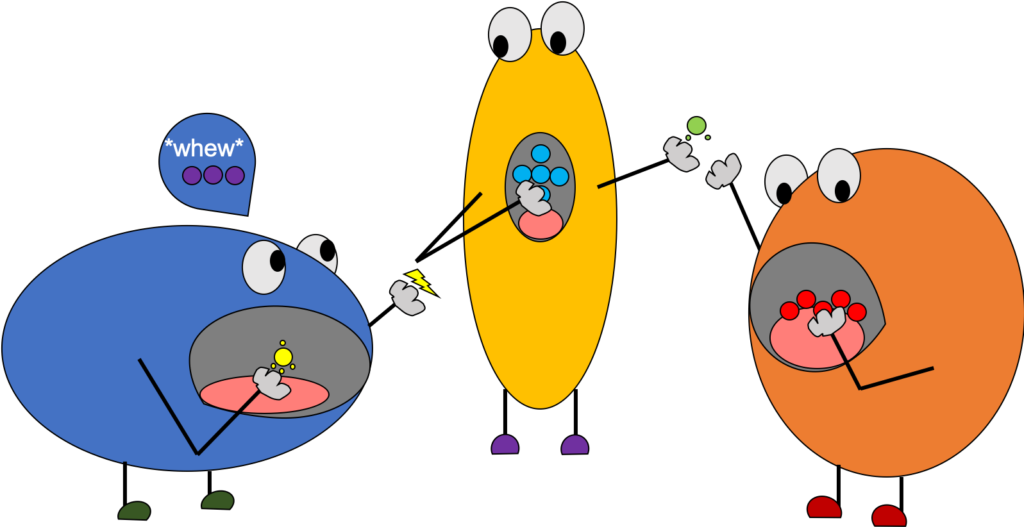Featured Image: Murky pond in Alaska with “rusty” iron-filled sediments. Image courtesy Jessica Buser. Used with permission.
Authors: Alina Mostovaya, Michael Wind-Hansen, Paul Rousteau, Laura A. Bristow, Bo Thamdrup
The table has been set and the food is all prepared. But this is no ordinary dinner party, it’s a microbe party! The guests sit down and proceed to dig into the main course; sulfur, rusty iron, and methane. Curiously, the guests are feeding each other, not themselves! This image seems pretty weird to us humans, but it’s a delight to these microbes. This collaborative method of eating occurs in pond and lake mud all around the world. In a new study, Mostovaya and colleagues describe one such feast in Danish Lake Ørn, that is not only collaborative but may mitigate climate change.
Methane is produces as microbes eat organic matter, such as leaf litter at the bottom of a pond. The gas bubbles up, travels through the water column, and is released into the atmosphere where it acts as an intense greenhouse gas, more potent than carbon dioxide. Scientists around the globe are attempting to better quantify these interactions to better understand climate change. Mostovaya and colleagues argue for the more work to better understand a process known as “anaerobic oxidation of methane”, where the methane never leaves the bottom of the freshwater pond. This process involves several different types of microbes in a highly orchestrated undertaking which includes sulfate, iron, and, of course, methane. In light of our changing climate, this seemingly small process sets the stage of a much broader carbon system as it dictates how much methane is being moved from the bottom of freshwater bodies into the atmosphere.
Freshwater contains very low quantities of sulfate, a form of sulfur that some microbes can “breathe”. In the same way humans breathe in oxygen and exhale carbon dioxide, these microbes breathe in sulfate and breathe out a form of acid that smells like rotten eggs. These “rotten egg microbes” partner with a different microbe that breathes methane (known as methanotrophs, meaning “methane nourishment”), converting it and exhaling carbon dioxide. The partnership is altruistic; when these processes are coupled its easier for both of them to breathe. This pair is well-described in the ocean, but it has been debated as to how ecologically impactful this partnership is in freshwater systems where sulfate levels are relatively low. Mostovaya and colleagues are able to show this process can happen when sulfate levels are surprisingly low in freshwater mud. There is a key to this, however, and that key is rust.
Rust comes into play as the previous microbial partnership consumes methane and sulfate. Rust acts as a catalyst to rejuvenate the rotten egg acid back to sulfate. There is a third microbial partner who handles the rust and facilitates this essentially instantaneous process, making sulfate constantly available to the “rotten egg microbe”. During this entire affair all three microbe partners are able to capture the energy available from their respective compounds as they change from one form to another (ex: methane to carbon dioxide). Additionally, the researchers found evidence that the methanotroph can consume methane using rusty iron independent of any other microbial assistance.

Ultimately this process involves three separate partners, all breathing either sulfate, methane, or ferric iron which collectively exhale acid, carbon dioxide, and iron, respectively. This system captures and consumes methane in the freshwater mud, keeping it from escaping into the atmosphere. As scientists continue to refine our knowledge on global carbon cycles and climate change, critical information as uncovered by Mostovaya and colleagues add new, complex layers that need to be taken into consideration. Much is still unknown about how freshwater systems contribute to climate change, especially as the ecosystems are rapidly changing. It’s been accepted up until recently that methane is widely released from lakes and ponds as it bubbles up from the mud, through the water column, and into the atmosphere. However, it is processes like the one described above that may prevent release of methane from freshwater systems, changing how scientists predict new climate scenarios. As methane is an incredibly powerful greenhouse gas capable of warming our planet more substantially than carbon dioxide, natural systems that capture this greenhouse gas is of increasing interest.
Metal-Eating Microbes Who Breathe Methane by Jessica Buser-Young is licensed under a Creative Commons Attribution-ShareAlike 4.0 International License.

